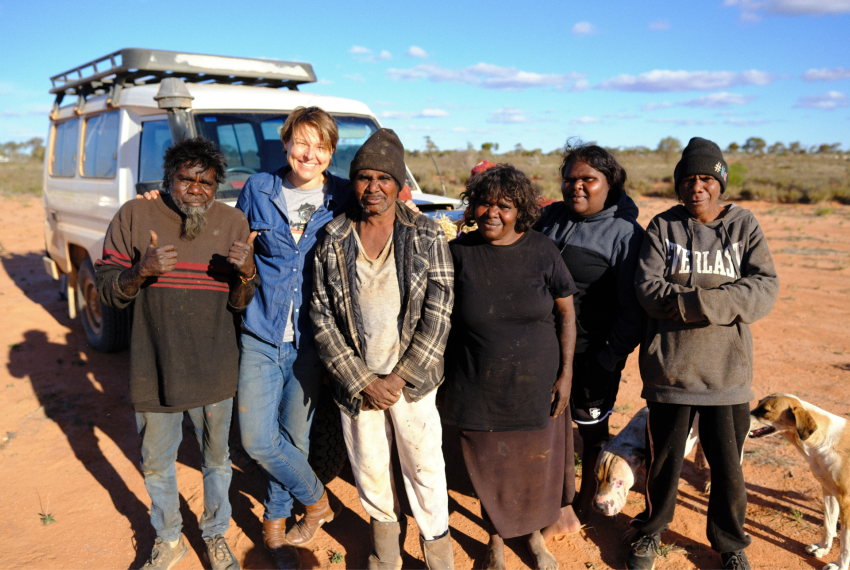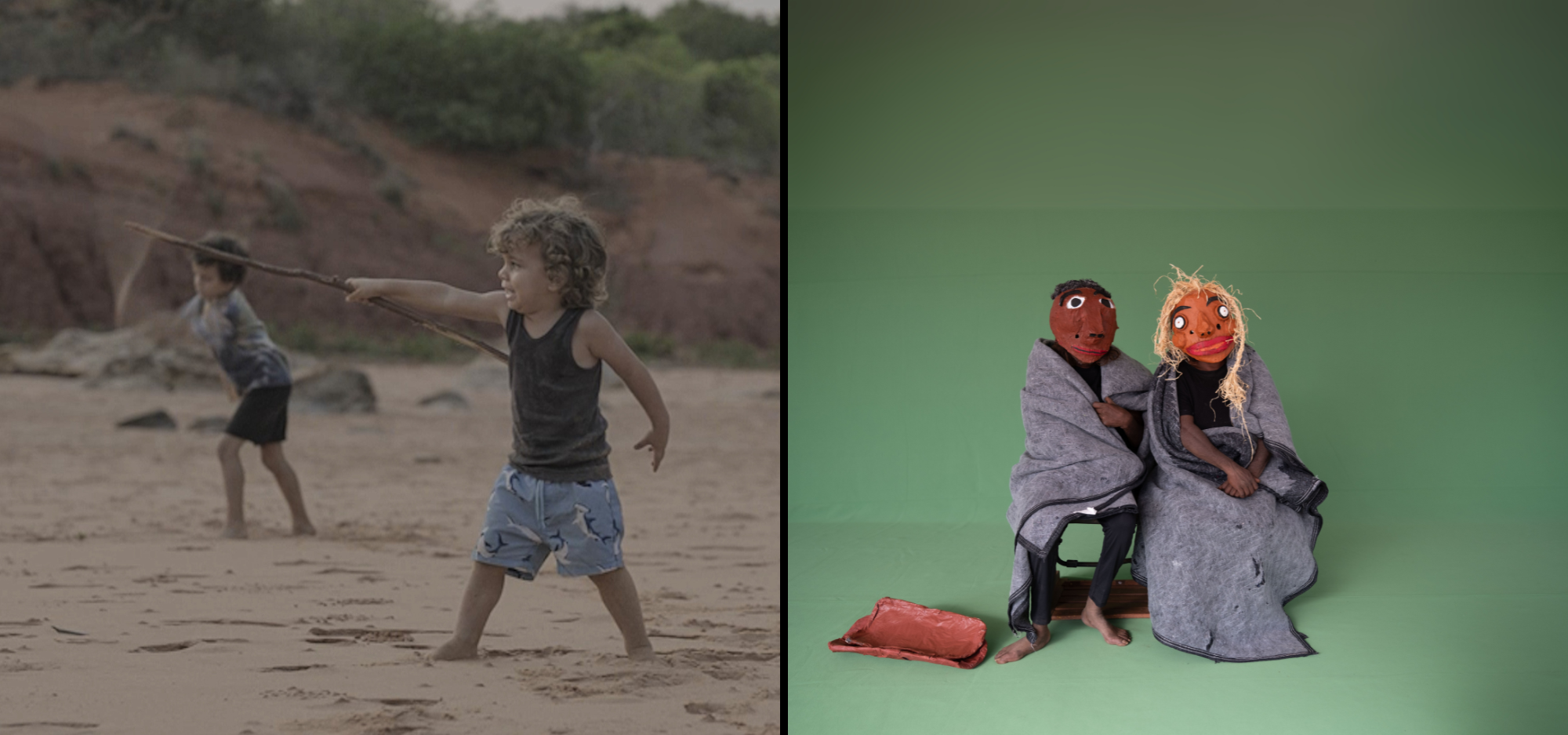Digital Public Art Program
Location
Perth Cultural Centre, Perth / Boorloo
Dates
Dates
Digital art installation at Boola Bardip
Showing daily.
Tickets
Free display
WA Museum Boola Bardip’s digital public art program features new Aboriginal digital artworks for 2025 showing on the Hackett Hall and Francis Street façades at WA Museum Boola Bardip throughout the year.
Newly commissioned digital artworks from Western Australian Aboriginal artists and content producers are front and centre at WA Museum Boola Bardip as part of the museum’s public art program.
Showing on the Hackett Hall and Francis Street façades at WA Museum Boola Bardip, the digital works are part of a public art program designed to expose emerging and established artists and their work to diverse audiences and have their work added to the WA Museum collection.
Stage four
Stage Four of the program features new digital artworks from Milpa Tjuntjuntjara and Michael Jalaru Torres. These works continue the project’s exploration of Aboriginal storytelling through digital mediums, reflecting on displacement, returning to Country, cultural knowledge and intergenerational storytelling.
55 Milpa artists, community members, non-Indigenous creatives and Spinifex painters came together to create two contemporary digital films reflecting on the forced displacement of the Spinifex people and their return to Country. Key collaborators Gregory Donaldson, Maureen Donegan, Janine Hogan, Ange Leech (Project Coordinator), Ningbell Lyons, Dianne Thompson, and Susan Young worked with visiting Western Australian creatives Steven Alyian, Dion Borrett, and Erin Coates to produce the multimedia art films.
Nguraku, a Pitjantjatjara term that translates to “returning home”, is a 24-meter digital artwork along the Francis Street Façade that takes viewers on a geographical and chronological journey, tracing the Spinifex people’s forced displacement following atomic testing in the 1950s and 60s to their return and re-establishment of Tjuntjuntjara, 600km northeast of Kalgoorlie in the Great Victoria Desert.
A Tjuntjuntjara Story is a short documentary blending black pen drawings with real footage, narrated by community members. Showing on the exterior of Hackett Hall, this film shares personal memories and lived experiences of returning home.
Michael Jalaru Torres, a Djugun-Yawuru photographer and filmmaker, presents a short story exploring how stories are passed down orally to the next generation on Country.
In Gudjarra Babali (two brothers), two brothers listen as their grandmother talks of the dangers of playing too deep in the mangrove forest, sharing an old story of two brothers who got lost and were never seen again. A Djugun story that has been passed down for generations in Broome, the work reflects on how oral stories are often not linear but instead told in stages.
Showing on the exterior of Hackett Hall, the film's animation is based on sketches by Michael’s son, River Torres, with family members acting out the story shot on Djugun Country, continuing the tradition of passing down knowledge through storytelling. The work extends onto the Francis Street Façade, with a 24-meter wide living artwork merging Michael's imagery with his son's, illuminating the journey across Country.
Djugung Story Advisor: Elder Pat Torres
Writer/Cinematographer/Editor/Director: Michael Jalaru Torres
Actors: Alison Torres, River Torres, Kazali Rahman, Jivan Gerschwitz-Torres, Amos Torres
Narration: River Torres
Sound Design: Petrix Jinuyili Torres
We acknowledge our family and Elders for passing down these stories to us: Karim bin Drummond, Irene Drummond, Cassimer Torres and Mary Theresa Barker. Gudjarra Babli is a 100% First Nations production informed by traditional cultural knowledge, filmed on Djugun Buru.
About the public art program
As part of the redevelopment of the WA Museum site in Perth, a public art program was established to expose emerging and established artists and their work to diverse audiences and include their work in the WA Museum collection.
A strategy was developed to curate and commission digital Aboriginal artworks for two digital screen installations on the WA Museum Boola Bardip's façade with funding allocated over four years.
The WA Museum engaged the Aboriginal Art Centre Hub Western Australia (AACHWA) to run an expression of interest process to select suitable artists and content for stages two, three and four. AACHWA's engagement extended to project coordination and providing cultural advice with AACHWA CEO Chad Creighton, a Bardi and Nyul Nyul man from the Kimberley, leading the curatorial process in collaboration with WA Museum.
Header image is a combination of imagery from the Milpa Digital Art Project and Michael Jalaru Torres.
Discover our artists

Milpa (Spinifex Arts Project Tjuntjuntjara)
Located in the remote Western Australian town of Tjuntjuntjara, Milpa (est. 2018) is a small, creative studio operated by the Spinifex Arts Project for the local community.
The studio focuses on creating new artworks through film, animation, model making, and more. The Milpa Digital Artworks, created by and for the community, serve as an important creative and contemporary record of significant cultural stories. These stories have been screened across Australia and in the USA.
Through digital media, artists of all ages and experience levels at Milpa have produced animations and artworks that capture and express their ideas, cultural values, and humor, all under the cultural guidance of senior artists and community members.
Image credit: Leading artists from the Milpa Project, on the Tjuntjuntjara football oval. L-R: Artists Gregory Donaldson, Ange Leech (Project Coordinator), Susan Young, Dianne Thompson, Ningbell Lyons and Maureen Donegan. Photo by Dion Borrett, 2023.
Michael Jalaru Torres
Michael Jalaru Torres is an Indigenous fine art photographer and poet from Broome, Western Australia. A Djugun-Yawuru / Jabbir Jabbir man with connections to the Gooniyandi / Ngarluma peoples, he draws inspiration from the unique landscapes and people of the Kimberley region.
His photography explores contemporary social and political issues Indigenous people, drawing on his own stories and personal history. Known for his conceptual portraiture and abstract landscape photography, Michael pushes the boundary of the medium, experimenting with installations and motion work.
He is also the founder of Blak Lens, a community-made collective of established, emerging, and aspiring Blak photographers and videographers across Australia.
Through his work, Michael not only celebrates the unique cultural heritage, experiences and perspectives of Indigenous Australians, but also highlights the ongoing struggles and injustices faced by these communities today.
Explore previous stages of the Digital Art Project
Stage one which was displayed from 2020 to 2022, featured licensed works by approximately 100 Aboriginal artists from around Western Australia, including the Kimberley, South West, Pilbara, Mid-West and Goldfield-Esperance. These were drawn from the State's collection held by the Art Gallery of Western Australia, and artworks from the 2020 Revealed exhibition, which was presented online due to COVID-19 restrictions.
In partnership with Sohan Ariel Hayes Studio and the Aboriginal Art Centre Hub WA, the WA Museum launched Artist in Focus; a deeply enriched series of short films celebrating Aboriginal art and storytelling.
Artist in Focus is screening until February 2023 at the WA Museum Boola Bardip in the Perth Cultural Centre, and on the long ribbon screen on Francis Street.
A year in the making, the four 15-minute short films showcase WA Aboriginal Artists to the wider community through the lens of independent filmmaking and storytelling.
Using a two-way learning process that prioritises the Artist’s voice filmmakers Sohan Ariel Hayes and Devris Hasan settled on a format that is part documentary and part visual storytelling, allowing the Artist’s to share with a wider audience their creative journey and communicate some of the unique experiences which have shaped their lives and practice.
These films form part of a four-stage Aboriginal Digital Artwork project designed to platform Aboriginal artists from across Western Australia to tell their stories and share their art on a national scale. Artist in Focus was commissioned by WA Museum as part of the New Museum Project and the State Government’s Percent for Art Scheme.
“The Western Australian Museum is proud to work with Aboriginal artists from around the State and commission new digital works for the State Collection which will be featured at Boola Bardip. Boola Bardip means ‘many stories’ in Nyoongar language and this project provides a vehicle for these artists to tell their stories, their way,” WA Museum CEO Alec Coles said.
In addition to welcoming Artist in Focus to the digital screens this week, WA Museum has also commissioned stages three and four of the project. We look forward to sharing these works with the community in the future.
Stage Three of the program features work from Brad Coleman, Laurel Nannup, Brett Nannup, Patrick Carter and Big hART, these works explore themes of the Stolen Generation, Nyoongar culture, and matriarchal leadership.
Animator Brad Coleman worked with renowned Nyoongar artists Laurel and Brett Nannup to animate Laurel's woodcuts, linocuts and etching prints in a piece titled Another Story To Tell, reflecting her experience as a Stolen Generation survivor.
Patrick Carter is a Nyoongar interdisciplinary artist; in collaboration with mentors, renowned Ballardong Nyoongar actor Kelton Pell and Sam Fox, Patrick has developed Kaya Boodja. The work focuses on Carter’s artistic response to Country and includes painting, performance, dance, song and animation of painted works.
Content producer Big hART filmed and created two new digital artworks on Ngarluma and Yindjibarndi country in the Pilbara using film, animation, photography and audio.
Jarda Bura, Gurri Bura, Jarda Ngarli, Gurri Ngarli (Senior Woman, Young Woman) highlights women’s stories of strength and the knowledge and leadership they draw from the relationships between mothers, grandmothers, daughters, sisters and aunties.
Wangaba Barnigu, Wangabani (Staying Alive) is inspired by exploring and observing local plants, trees and wildflowers from Country through photography and digital drawing. This film features the artwork and photography of young women from Roebourne.
Plan a visit
Showing on the Hackett Hall and Francis Street façades digital screens
